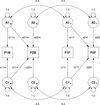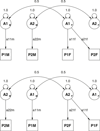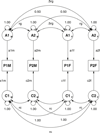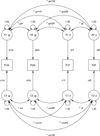Multivariate genetic analysis of sex limitation and G x E interaction
- PMID: 16899154
- PMCID: PMC4246510
- DOI: 10.1375/183242706778024937
Multivariate genetic analysis of sex limitation and G x E interaction
Abstract
Sex-limited expression of genetic or environmental factors occurs in two basic forms. First, the effects of a factor may be larger on one sex than on another, which is known as scalar sex limitation. Second, some factors may have an effect on one sex but not on the other, which is called nonscalar sex limitation. In the classical twin study, scalar sex-limited effects cause same-sex male and same-sex female twin correlations to differ. Nonscalar sex-limited effects would cause the correlations between opposite-sex pairs of relatives to be lower than would be expected from the correlations between relatives of the same sex. One approach to modeling such effects is to allow the genetic correlation between opposite-sex dizygotic twins to be less than one-half; another is to allow the common environment correlation for opposite-sex pairs to be less than unity. Extension of this approach to the multivariate case is not straightforward. Direct extension of the Cholesky decomposition such that each Cholesky factor is allowed to correlate less than one-half in opposite-sex pairs yields a model where the order of the variables can change the goodness-of-fit of the model. It is shown that similar problems exist with a variety of multivariate and longitudinal models, and in a variety of models of genotype x environment interaction. Several solutions to these problems are described.
Figures







Similar articles
-
Etiology of individual differences in reading performance: a test of sex limitation.Behav Genet. 1995 Jan;25(1):17-23. doi: 10.1007/BF02197238. Behav Genet. 1995. PMID: 7755515
-
Genetic and environmental influences on Anxious/Depression during childhood: a study from the Netherlands Twin Register.Genes Brain Behav. 2005 Nov;4(8):466-81. doi: 10.1111/j.1601-183X.2005.00141.x. Genes Brain Behav. 2005. PMID: 16268991 Clinical Trial.
-
Implications of absence of measurement invariance for detecting sex limitation and genotype by environment interaction.Twin Res. 2004 Jun;7(3):292-8. doi: 10.1375/136905204774200578. Twin Res. 2004. PMID: 15193174
-
Heritability of central corneal thickness in Chinese: the Guangzhou Twin Eye Study.Invest Ophthalmol Vis Sci. 2008 Oct;49(10):4303-7. doi: 10.1167/iovs.08-1934. Epub 2008 May 23. Invest Ophthalmol Vis Sci. 2008. PMID: 18502994
-
Analyzing twin resemblance in multisymptom data: genetic applications of a latent class model for symptoms of conduct disorder in juvenile boys.Behav Genet. 1993 Jan;23(1):5-19. doi: 10.1007/BF01067550. Behav Genet. 1993. PMID: 8476390
Cited by
-
Common Etiological Sources of Anxiety, Depression, and Somatic Complaints in Adolescents: A Multiple Rater twin Study.J Abnorm Child Psychol. 2016 Jan;44(1):101-14. doi: 10.1007/s10802-015-9977-y. J Abnorm Child Psychol. 2016. PMID: 25619928
-
Diagnostic and genetic overlap of three common mental disorders in structured interviews and health registries.Acta Psychiatr Scand. 2018 Jan;137(1):54-64. doi: 10.1111/acps.12829. Epub 2017 Oct 26. Acta Psychiatr Scand. 2018. PMID: 29072781 Free PMC article.
-
Causal and common risk pathways linking childhood maltreatment to later intimate partner violence victimization.Mol Psychiatry. 2025 May;30(5):2027-2037. doi: 10.1038/s41380-024-02813-0. Epub 2024 Nov 2. Mol Psychiatry. 2025. PMID: 39488656 Free PMC article.
-
A multivariate twin study of autistic traits in 12-year-olds: testing the fractionable autism triad hypothesis.Behav Genet. 2012 Mar;42(2):245-55. doi: 10.1007/s10519-011-9500-3. Epub 2011 Sep 7. Behav Genet. 2012. PMID: 21927971 Free PMC article.
-
Evidence for Common Etiological Influences on Early Literacy Skills in Kindergarten.Sci Stud Read. 2012 Jan 1;16(5):457-474. doi: 10.1080/10888438.2011.599902. Epub 2012 Jan 9. Sci Stud Read. 2012. PMID: 23204828 Free PMC article.
References
-
- Carey G. Cholesky problems. Behavior Genetics. 2005;35:653–665. - PubMed
-
- Eaves LJ, Last K, Young PA, Martin NG. Model fitting approaches to the analysis of human behavior. Heredity. 41:249–320. (978). - PubMed
-
- Kendler KS, Heath AC, Martin NG, Eaves LJ. Symptoms of anxiety and symptoms of depression: Same genes, different environments? Archives General Psychiatry. 1987;44:451–457. - PubMed
-
- Lubke GH, Dolan CV, Neale MC. Implications of absence of measurement invariance for detecting sex limitation and genotype by environment interaction. Twin Research. 2004;7:292–298. - PubMed
-
- Maes HH, Neale MC, Martin NG, Heath AC, Eaves L. Religious attendance and the frequency of alcohol use: Same genes or same environments: A bivariate extended twin kinship model. Twin Research. 1999;2:169–179. - PubMed
Publication types
MeSH terms
Grants and funding
LinkOut - more resources
Full Text Sources

